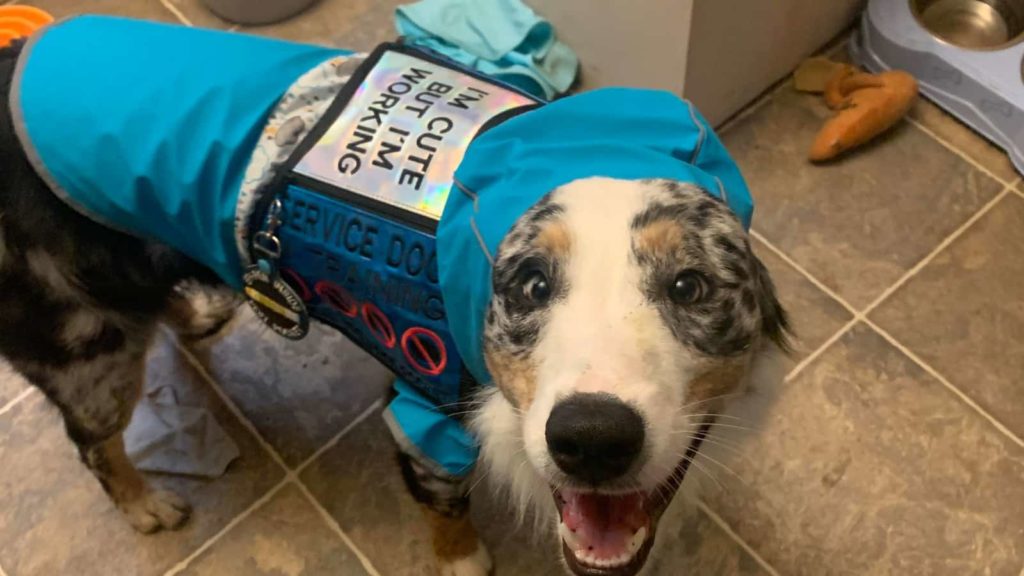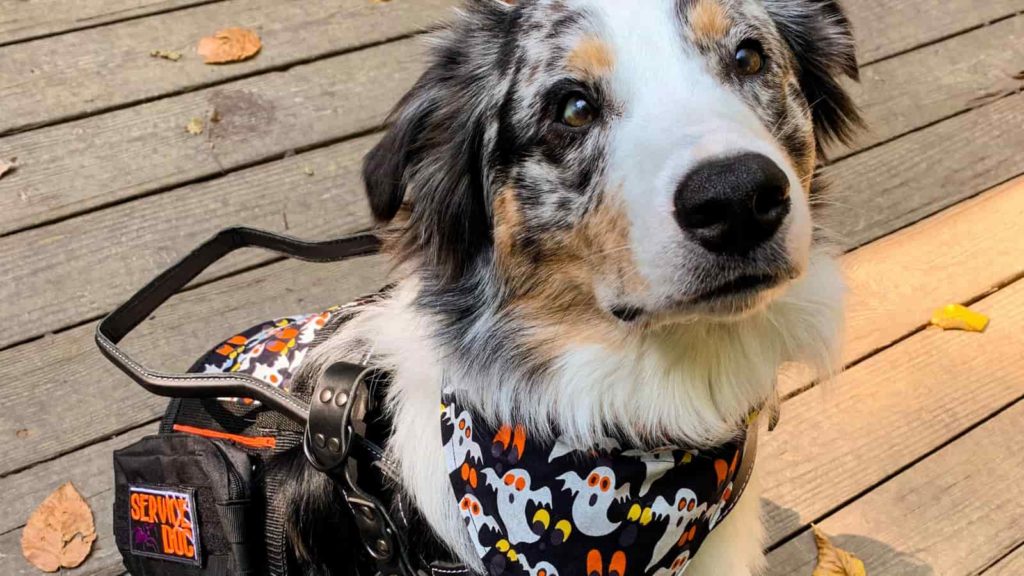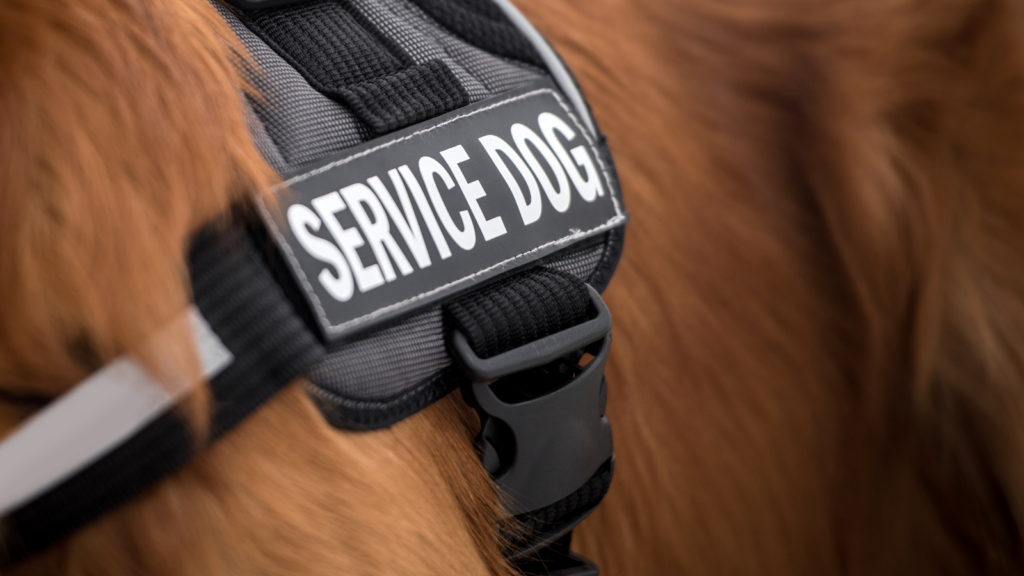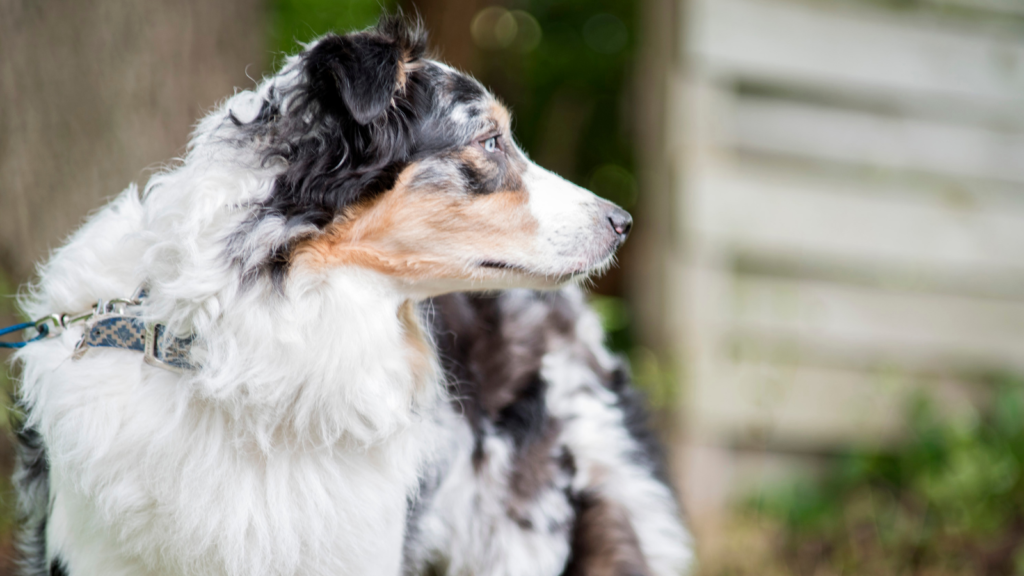Australian Shepherds are known for their intelligent, reliable, and energetic personalities. A lot of traits that Aussies possess are key qualities that a service dog must have.
Australian Shepherds are known for working as service dogs; however, each dog needs to be tested for the right drive and temperament before deciding if they are a good fit for this role. The way they are raised and trained can make or break whether an Aussie becomes a great service dog or not.
Many different types of service dogs can assist their handlers with tasks that they may not be able to achieve themselves. If you are interested in learning more about Aussie service dogs, be sure to read to the end so you don’t miss the personal story and experience of Jenny C. who owns this adorable Aussie service dog.

Do Australian Shepherds Make Good Service Dogs?
Australian Shepherds can be great service dogs because of their drive to work and please their owners. Because of their high energy, it’s important to choose a dog whose temperament will be a good fit for this job. They are especially great at being therapy and emotional support dogs.
Here are some traits that Aussies tend to possess that make them great service dogs:
- Intelligent
- Affectionate
- Aware/Alert
- Reliable
- Obedient
- Calm
- High work ethic
Note: Aussies are often born with the traits that make them great service dogs, but if they are not extensively trained, they may not do well as working service dogs.
Aussies are very smart, loyal, and love having someone to be with at all times. Loyalty is a necessary trait for any service dog. Along with being extremely friendly and energetic, Aussies are also usually very easy to train.
One trait that makes Australian Shepherds exceptional service dogs is their ability to maintain their youth. An Aussie life typically ranges between 10–14 years. Maintaining youth throughout their time as service dogs can help greatly when they are required to help their handler consistently and effectively.
Since Australian Shepherds were originally herding dogs, they already have a lot of traits that make them great service dogs; specifically, being able to guide their handler. Their herding behavior contributes to them being able to lead their handler with caution and care.
Being a larger breed dog is also an advantage that Aussies have as service dogs. They can easily help any handler that has balance or mobility issues!
Disclaimer: This post may contain affiliate links. We only recommend high-quality products that are used and recommended by real owners. If you use these links to buy something we earn a small commission.
How to Get an Aussie Service Dog / Who Qualifies?
Service dogs are only given to people with disabilities that affect their quality of life. Meeting with a healthcare professional is the first step in receiving an Aussie service dog.
Different service dogs have different methods to obtain them. For example, to receive a psychiatric service dog, it’s helpful to have a licensed mental health professional provide a statement saying that you are able to obtain a service dog.
For physical disabilities, it’s helpful to also meet with your doctor and have them provide the necessary statements as well; this is the easiest and best way to receive a service dog.
If your healthcare provider states it is necessary for you to have a service dog, the next step is to find an Aussie that you love and set them up with a professional service dog trainer or service dog program, you also have the option to train the dog yourself!
If you are interested in your Aussie becoming a service, therapy or emotional support dog, keep reading to find out more!

Types of Service Dogs
The term “service dog” is a very broad definition. This term typically describes dogs that are trained to perform tasks for people with disabilities or impairments who otherwise could not accomplish the task.
There are many different types of service dogs that specialize in helping people with different disabilities. Service dogs must undergo intense training, they are not household pets. Here are some of the different types of service dogs:
- Guide Dogs: These types of dogs will be able to assist their handler who has vision loss or impairment. They will help their handler avoid any dangerous situations (like running into obstacles). They will also complete tasks such as opening doors, helping their handler with transportation, and helping them cross the street.
- Hearing Dogs: These dogs assist their handlers with sounds they can’t hear themselves. They can alert their handler to sounds such as smoke or fire alarms, doorbells, alarm clocks, phones, etc. They will also guide their handler out of any dangerous situations that a certain sound may signal.
- Medical Alert Dogs: These dogs can help their handlers who suffer from seizures, epilepsy, diabetes, and other medical conditions. Medical alert dogs can notify their handler of any upcoming medical emergency that they sense and get them to safety as quickly as possible (for example: if their handler is about to have a seizure). They can also help with other conditions such as heart disease, allergies, and asthma.
- Mobility Assistance Dogs: These dogs can help their handler who suffers from spinal injury or other injuries that have affected their ability to walk, stand, or balance. These dogs can help their handler walk, stand, and retrieve items for them so that they don’t have to move.
Psychiatric Service dogs are different types of service dogs. These dogs assist people with mental disabilities, mood disorders, or any unseen/unnoticeable disabilities. These dogs experience specialized training that will teach them how to help their owners with any needs they may require. Here are some tasks that a psychiatric service dog may perform:
- Retrieve medication/remind handler to take their medication
- Find quiet space for their handler
- Provide comfort
These dogs are tasked to assist with mental health issues rather than mobility issues. They can assist anyone suffering from depression, Post-traumatic stress disorder (PTSD), anxiety, panic attacks, etc.
Here are some other tasks and conditions that both service dogs and psychiatric service dogs can complete and assist with:
- Retrieve help
- Pull wheelchair
- Retrieving dropped items
- Night terror alert
- Providing distraction for handlers with repetitive behaviors (such as obsessive-compulsive disorder (OCD))
- Pressure therapy (grounds the individual and offers a distraction from anxiety, depression, panic attacks, etc.)
- Autism assistance
- Attention-Deficit/Hyperactivity disorder (ADHD)
- Bipolar
- Social Phobia
- Claustrophobia
- Schizophrenia

Types of Assistance Dogs
According to the Americans with Disabilities Act (ADA), dogs that are not required to undergo intense training are not considered service dogs. These dogs include therapy and emotional support dogs.
Therapy dogs provide emotional support and comfort to people who are or have experienced traumatic or stressful situations. These dogs are often used in nursing homes, hospitals, or brought to people after they have experienced stressful situations.
While these dogs do not perform specific tasks for people with disabilities and are not required to receive intense training, they are required to undergo a test arranged by the American Kennel Club (AKC) which is called the “Good Citizen Test.”
This test ensures that the dog can complete tasks such as walking on a leash without pulling, not barking, growling, or biting, and ensuring that they obey their handler. Therapy dogs are at-home pets when they are not providing support to other people.
The other type of assistant dog that requires no intense training is an emotional support dog. This type of dog can provide emotional support to its owner. There is no requirement for training or even a test for a dog to become an emotional support animal; however, a note from a professional healthcare provider is required.
For all your questions about service dogs and information about what makes a service dog and therapy/emotional support dog different visit this website: ADA Frequently Asked Questions
Do Australian Shepherds Make Good Emotional Support / Therapy Dogs?
Aussies are not only great emotional support dogs because of their personalities, but they are also typically attached to their owners. They love to please! This is a great trait not only for an emotional support dog but a service dog as well!
Aussies are alert and aware of their owner’s presence, always making sure they are okay, their mental alertness is incredible.
8 Reasons Why your Australian Shepherd Follows You Everywhere!
Aussies are natural socializers and are also comfortable in many different situations. They like to be petted and greatly enjoy human interaction, this is a great trait for therapy and emotional support dogs!
Tip: It is important to keep your Aussie constantly socializing if you are planning on them being a therapy/emotional support dog and also keeping them as an at-home pet/family dog; attachment to one owner may become an issue. Your Aussie may become more loyal to one person and not have interest in engaging with other family members or people.
Rights for Service Dogs
Only service dogs and psychiatric service dogs that have extensive training are officially recognized as service dogs and are protected under federal rights. Therapy and emotional support dogs are not protected under these rights since they are not required to have extensive training.
These rights include the dog being able to accompany its handler anywhere. Here are some of the rights that are given to people with service dogs:
- Public access (including hospitals, hotels, stores, restaurants, etc.)
- Travel (Click here for more information on traveling with a service dog.)
- Fair housing
- Educational Facilities
As long as the service dog is well behaved, harnessed, and does not break any public health rules, the dog will be permitted anywhere.
Service Dog Certification and Registration
Certifying and registering your service dog is not required in the United States; however, it is helpful in order to avoid any complications. Your dog will receive official paperwork, a service dog ID, a service dog vest, and will be entered into a global database.
Having your dog certified and registered will help situations like travel become easier.
Note: Training does not end here! Becoming a service dog is a lifetime commitment. A service dog must pass two more tests (first at 2 years of age, and then another third test). A service dog must then be tested every 18 months for the rest of its life to ensure its abilities and to keep its certification valid — It’s a good thing Aussie’s have a lot of energy!

How Does an Australian Shepherd Become a Service Dog?
For an Australian Shepherd to become a service dog, they must complete intense training throughout their lives.
Service dogs typically begin training around 6 weeks of age; they must pass their first test by age 2. Since Aussies are very sociable dogs, they are typically ready to start at this early age because they are eager to please.
It is also helpful to begin an Aussie’s training as early as possible because they are known to be a stubborn breed. If they begin training at a later age, it may take longer to train them because they are already too independent and used to their current way of doing things.
Note: Aussies are exceptionally great at working as seeing-eye dogs because of their history in herding!
Here are some of the necessary steps an Aussie must take to ensure that they turn out to be a great service dog:
1. Training (professional trainer or trained by owner/handler)
2. Pass public access test
3. Service dog certification and registration (not mandatory)
4. Further training
5. Training dog certification test (separate test)
How Do I Train My Aussie by Myself to Be a Service Dog? (Step-By-Step)
Since certification and registration are not mandatory for service dogs, you may decide to either hire a professional service dog trainer or train your Aussie by yourself. Unless you are very experienced with training dogs it’s recommended that you get professional help.
Tip: Be aware that training your Aussie yourself to become a service dog will take a lot of time and commitment!
First Step (Training):
- Start socializing your Aussie at an early age (typically around 6 weeks)
- Aussies rely on praise to know that they are doing well, by rewarding them, they are more likely to keep achieving tasks consistently.
Tip: Since Aussies love being rewarded for their good behavior, they are compelled to complete their tasks if they think they will receive a reward.
- One method that is popular with training Aussies is using a clicker. If the dog hears the click of the button that their handler is pressing, they will do the behavior or task because they associate the noise of the clicker with the reward that they know they will be receiving if they do the job well!
- The goal of the clicker is to slowly ease off of how many treats the dog is receiving, making it to where they will achieve the behavior or task just by the clicking noise alone, not expecting a treat in return.
- Be consistent! — It is important to constantly train your Aussie if you want them to become exceptional service dogs. It is also necessary that you maintain a consistent training schedule to keep the dog on track.
Second Step (Testing):
- Aussies must complete a public access test that proves they can control themselves in public. This test is designed to ensure that the Aussie can present good behaviors and is not distracted or prone to any inappropriate behaviors in public settings. Some of these unacceptable behaviors include:
- Attention seeking
- Whining for food
- Getting overexcited
- Barking
- Aggression
A service dog participating in this test will also need to know verbal and hand signals such as sitting, waiting, walking quickly or slowly, etc.
Third Step (Becoming a Service Dog):
Once your service dog completes the necessary training. It is up to you to decide whether or not to receive their certification and registration.
Oftentimes service dog owners find it helpful to have certification and registration proof for their service dog to set appropriate boundaries with strangers or in public settings.
It is also important that the service dog upkeep their training for the rest of their lives!

Should I Get an Australian Shepherd Service Dog?
Whether or not someone should get an Australian Shepherd service dog depends greatly on what the handler’s condition is.
Since Australian Shepherds are athletic and require frequent exercise, this may be an issue if their job requires them to be still for long periods.
Aussies tend to excel as service dogs with handlers who can keep them moving (example: a guide dog that is required to lead their handler around — seeing-eye dog). Aussies may be better suited to assist as a service dog for a handler that can be in motion — Aussies may become restless by being still for long periods.
Tip: Keep in mind that Aussies’ coats need constant upkeep. If a handler is unsure whether they can maintain their dog’s coat, it may be a good idea to consider a service dog with an easily maintainable coat. For more information on maintaining Australian Shepherd Grooming, check out our comprehensive grooming guide: Australian Shepherd Hair Care (Complete Grooming Guide!)
How Much Does an Australian Shepherd Service Dog Cost?
Service dogs, in general, can range between $15,000–$30,000. Unfortunately, service dogs are typically not covered under health coverage, meaning that they can be very expensive.
An Australian Shepherd service dog in particular is more costly than some other service dogs. They typically range between $30,000–$38,000.
Prices of service dogs vary on multiple factors such as their specifically trained skills and what they are trained for (service dog, psychiatric service dog), their age, if they are purebred or not, etc.
Jenny’s Story
This is my boy cooper, he is a fully task-trained service dog. I was on a waitlist with a program however it’s a very long wait and Cooper came into my life with the right drive and temperament so it felt right. The training was thrilling yet excruciating.

Being chronically ill and trying to train your own service dog is not a task for the faint of heart. We worked closely with multiple trainers and every day was training. There were no breaks.
The goal was consistency and it definitely paid off in the long run. After two years of solid training, he is the best service dog I could’ve asked for.
He’s reliable with tasks and alerts and bulletproof to just about every situation he’s thrown into. He assists with multiple disabilities I have. The main one was a migraine detection alert.
I have what’s called Chiari Malformation, essentially a brain anomaly where the cerebellum herniates into the spinal cord. This causes debilitating migraines that range from extreme pain, dizziness, loss of vision, passing out, and vomiting.
He has a solid alert to these episodes usually an hour before. It usually gives me enough time to get to a safe place and take medication. If I can not and an episode comes on fast out of nowhere, he knows guide tasks such as “exit” where he will guide me out of a location, “car” “follow ____” “seat” (to find a safe place to sit), etc.
He does what’s called a counterbalance where I hold a flexible upright handle and if I were to lean in a dizzy spell, he uses his weight to counter my pull and keep me upright.
That’s some of the most used tasks he has but he has tasks like allergen detection, DPT, heart rate alerts, an alert for anaphylaxis episodes, just to list a few.

I get asked often if I would recommend Aussies as service dogs and the short answer is no. They’ve blown up in the service dog community and for many reasons, I can see why. They’re smart, they learn quickly, they have the drive. But with poor breeding being such a big thing along with people jumping the gun on getting any dog for their service dog prospect, it’s usually not a good choice.
The breed tends to be high strung, has a very high prey drive, can be nervy, and are incredibly high energy.
When we found my boy, he was temperament tested on multiple occasions and was found to be relatively low energy. He was non-reactive to dogs, people, or small prey, and overall checked all the boxes.
Having a solid genetic line is key. At two years old he went through getting OFA scores and clearing his hips and joints overall.
This is important to make sure your dog is physically fit to not only be doing mobility tasks but to be working as a whole. Aussies are prone to having visual issues along with MDR1. MDR1+ dogs should absolutely not be working as they are exposed to every little thing.
On top of that, health certificates are needed to travel on airlines and for most hotels. It’s a basic clearance by your vet saying your dog is up to date on vaccines and is healthy to travel. It’s costly to say the least and that’s why it’s important to have a solid healthy dog.
I’ve talked to multiple Aussie “handlers” with SDiT, and all have given me a reason to believe their dogs are not cut to be working. Dog reactive, anxious, no leash manners, etc. it’s a shame that these people are the face of the service dog community when they continue to work dogs that shouldn’t be working.
I have three Australian shepherds and there’s a reason only one is a working dog. The other two are the stereotypical Aussie, high drive high energy. They are nonstop and we’ve taken the drive and put them in sports like lure coursing, agility, dock diving, bikejoring, and barn hunt.
A Huge Thank you to Jenny for sharing her experience!
Click Here for all the questions you have about Aussies! And check out these articles next (all about different service dogs!):
Can A Chihuahua Be A Service Dog? (How to Train Them)
Can A Jack Russel Terrier Be A Service Dog? (Your Complete Guide)
Can A Cocker Spaniel Be A Service Dog? (Your Complete Guide)



